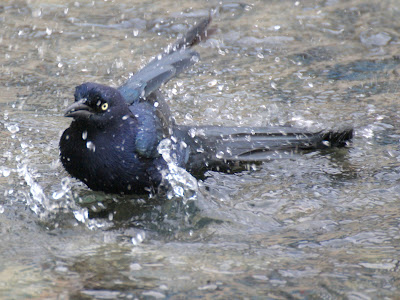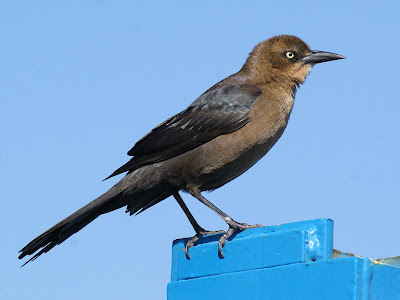.
Well, our ninth year in Texas is at an end - and quite a year it was, too! The final few months were particularly good.
A short trip to San Francisco let us catch up on western birds, including this Burrowing Owl.
It was also good to see the Pier 39 sea lions again.
However, the most exciting place to be was the Katy Prairie. A few unusual birds always turn up there in the winter and so it was not totally surprising to see the occasional Pyrrhuloxia.
Having three species of Towhee was unexpected, though.
Eastern Towhee
Spotted Towhee
Just as unexpected was seeing Lark Buntings by the score and Harris's Sparrows by the dozen.
Lark Bunting
Harris's Sparrow
The influx of uncommon birds on the Katy Prairie was the main reason I managed to get my Harris County year list to over 200 (203) species for the first time. A great way to end the year!
.
.
Dee and I are in the UK for Christmas and we won't return until New Year's Eve. We're spending the holiday with family but I'm fitting in a little birdwatching.
While we're away, I'm still be blogging about Texas , using photos and other material from December that I haven't managed to post yet.
Here are some photos that I took on a recent visit to Baytown Nature Center. This isn't one of the best birding sites in our area but it usually has a few interesting birds. On my latest visit these included Horned Grebes, Red-breasted Merganser and Hooded Mergansers. Also, it's a great site for watching Ospreys!
Double-crested Cormorant
Snowy Egret
Osprey
Horned Grebe
Spotted Sandpiper
Loggerhead Shrike
Great Blue Heron
.
.
It has been fairly quiet in our yards lately. We still get a good selection birds but not in the numbers that we usually see at this time of year. Unfortunately, there is an exception: House Sparrows. Rather than the occasional bird or pair of these birds that we normally see, there are now often half-a-dozen at our feeders. I hope they are not driving away some of our native birds!
Our most frequent visitors are Carolina Chickadees. They visit our feeders every minute or two throughout the day.
A couple of Orange-crowned Warblers are very regular visitors, too.
A Ruby-crowned Kinglet which comes to our suet feeders several times a day is always a welcome sight.
A male and female Downy Woodpecker appear to take turns at two other suet feeders. They usually defend "their" feeders from other birds, and so the other day I was surprised to see a Downy and a Yellow-rumped Warbler both eating from the same feeder without any conflict.
Perhaps like the rest of us the Downys were trying to get into the Christmas spirit. Unfortunately, the Yellow-rumped doesn't seem to know about paying forward. It constantly chases away Orange-crowned Warblers and other Yellow-rumpeds. The other way it chased off the only American Goldfinch that has reached our yards so far this year.
.
.
I've always been very fond of Pelicans. They are such extraordinary-looking birds.
Many people prefer White Pelicans, partly because of their plumage but sometimes also because of the way they fish in groups, forming a circle or line on the water with their companions and then reaching down in unison into the water to scoop up their prey.
It's a while since I've had a chance to watch White Pelicans fishing, though, as the only ones I've seen recently are the ones I saw circling high overhead at San Jacinto Monument park last weekend.
I prefer Brown Pelicans. They may be almost prehistoric in appearance but even when they are not in breeding plumage, adults are quite beautiful.
Although they are much smaller than their white cousins, they still have an impressive wingspan.
I always enjoy watching lines of Brown Pelicans as they patrol the shoreline, making spectacular vertical dives into the water when they spot fish.
Oddly enough, the other day I watched several Brown Pelicans using a very different fishing technique. These birds were floating on shallow water. Every so often they would launch into flight but would fly for just a few yards, staying only feet above the water. Then they would splash down to grab their prey.
They would float with their bill held down for a couple of minutes, presumably to let water drain out. Then they would raise their head to swallow whatever it was they had caught.
BTW, the bird in the four photos above is a first-year bird, which is why it doesn't have any white on its head and neck.
.
.
As you'll have noticed, I use a lot of photos in my blog. This is essential because I'm not a good enough writer to do justice in words to the birds and other wildlife that I see! Luckily, modern camera technology means that taking reasonable photos is much easier than it was years ago, even if you use inexpensive equipment like mine. Having said that, though, some subjects are still difficult to photograph. For example, over the past couple of weeks I've been struggling to take recognizable pictures of two species - American Kestrel and Fox Sparrow.
I've seen a lot of Kestrels perched on wires and posts as I've been driving around our area lately. Unfortunately, they normally fly off as soon as I stop the car and well before I can open the window and use my camera.
This week I finally came upon a Kestrel that was less skittish. (Or perhaps it's just that it was early and the bird was still only half-awake!) Since the bird was silhouetted against the sky, the photos I got weren't great but at least you can see the bird's main features.
Fox Sparrows pose different problems. First of all, they are not at all common in our area. Also, they are generally secretive birds that forage mainly in the undergrowth and don't often spend much time out in the open. Then I personally run into a third problem with them: My camera is so noisy that the birds tend to run for cover the instant that I take my first photo. I then have to wait quietly for ages, hoping that they will re-emerge in more or less the same spot.
So last week I felt very fortunate when I came across a couple of Fox Sparrows that spent quite a while in the open and that didn't seem to be too bothered by the noise of my camera shutter.
BTW, there is another bird that I would love to photograph but haven't yet: Bewick's Wren. Like the Fox Sparrow, it's usually uncommon in our area but is turning up all over the Katy Prairie at present. If I ever manage to get a picture of one, you can be sure I'll be posting it here!
.
.
In my previous posting I mentioned that my Harris County life list had reached 250 species. Looking at the list, I realized that I had seen 196 species in the county this year. So I decided to see if I can get my Harris County year list up to 200 species, a total I had never previously imagined I could reach.
On my way home from work on Friday I added one more bird when a Long-billed Curlew unexpectedly appeared at Paul Rushing Park.
I thought the easiest way to reach 200 species would be to add some coastal birds, such as gulls and terns. (I see lots of these birds in a normal year but usually in Galveston County.) With this in mind, we headed down to the San Jacinto Monument park yesterday morning.
The area around the Monument had few birds, except for an American Kestrel, a Red-shouldered Hawk and four Black Vultures. The reflection pool had a flock of 30 Ruddy Ducks.
The boardwalk was more productive, immediately yielding a handful of Roseate Spoonbills and Snowy Egrets, some Double-crested Cormorants, a Northern Harrier and a Great Blue Heron.
It also had two of my target birds, Herring Gull and Forster's Tern, even though these werre too far away to photograph.
The path beyond the boardwalk had numerous Ruby-crowned Kinglets and a Hermit Thrush.
The open water had a couple of dozen Northern Shovelers while several small groups of White Pelicans circled overhead.
The final sighting was of a female Belted Kingfisher.
After our walk around the Monument park, we crossed over to Baytown via the Lynchburg ferry, accompanied by several Great--tailed Grackles.
Unfortunately, the Baytown Nature Center was almost empty of birds, and the mosquitoes were fierce. There were plenty of butterflies, though, including several Common Buckeyes.
So our trip ended with a whimper rather than a bang. But at least San Jacinto had produced two new species, taking my Harris County list to 198.
If I had 2-3 weeks left in which to add two new species to my list, I'm sure I could manage it. But there is only just over a week (with one weekend) to go before we fly to England!
.
.
The Katy Prairie continues to produce interesting sights day after day. Not all of them are beautiful, though.
On Longenbaugh I passed several Black Vultures feeding on an unidentifiable corpse.
On Porter Road I stopped when I noticed a Red-tailed Hawk standing over a cat carcass while a couple of Crested Caracaras and a Turkey Vulture lurked nearby.
When I got out of the car, the Red-tailed flew off and the three scavengers moved in.
More Turkey Vultures arrived.
They proceeded to squabble over the intestines, which they pulled further and further out and away from the body.
This gave the Caracaras a chance to move in and feed.
However, the commotion attracted the attention of some Black Vultures, whose arrival soon displaced the Caracaras.
By the time I left eight vultures and the two Caracaras were arguing over the carcass. At least it seems that none of the cat's corpse will go to waste.
P.S.
It wasn't all blood and guts, though. I finally managed to see and grab a (poor) photo of the Spotted Towhee that has been hanging out on Sharp Road.
The Towhee took my Harris County life list to 250 species.
.





























































